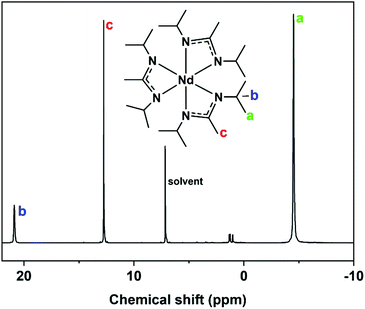 Open Access Article
Open Access ArticleCreative Commons Attribution 3.0 Unported Licence
Correction: Luminescent Nd2S3 thin films: a new chemical vapour deposition route towards rare-earth sulphides
Stefan
Cwik
a,
Sebastian M. J.
Beer
a,
Marcel
Schmidt
b,
Nils C.
Gerhardt
c,
Teresa
de los Arcos
d,
Detlef
Rogalla
e,
Jana
Weßing
a,
Ignacio
Giner
d,
Martin
Hofmann
c,
Guido
Grundmeier
d,
Andreas D.
Wieck
b and
Anjana
Devi
*a
aInorganic Materials Chemistry, Ruhr University Bochum, 44801 Bochum, Germany. E-mail: Anjana.devi@rub.de
bApplied Solid-State Physics, Ruhr University Bochum, Germany
cPhotonics and Terahertz Technology, Ruhr University Bochum, Germany
dUniversity Paderborn, 33098 Paderborn, Germany
eRUBION, Ruhr University Bochum, Germany
First published on 31st October 2019
Abstract
Correction for ‘Luminescent Nd2S3 thin films: a new chemical vapour deposition route towards rare-earth sulphides’ by Stefan Cwik et al., Dalton Trans., 2019, 48, 2926–2938.
The authors regret an incorrect assignment of proton signals in the 1H NMR spectrum of complex 2 [Nd(dpamd)3] (right spectrum in Fig. 2) which was published in their original submission. The correct NMR assignment is explained in the following text and depicted in Fig. 2:
In the 1H-NMR spectrum (Fig. 2) of the presented complex 2 [Nd(dpamd)3] the proton signal for the methyl moieties of the iPr-groups (“a”) is detected at −4.5 ppm exhibiting a total integral of 36 H. The lone protons of the CH moiety within the iPr group are shifted to the low-field regime at 20.9 ppm due to their close spatial distance to the Nd metal center. Furthermore, the integral of 6 H is in accordance to the suggested structure. This proton signal is assigned as “b”. The signal at 12.76 ppm (total integral of 9 H) can be unambiguously assigned to the CH3 moiety located at the NCN backbone of the ligand.
The Royal Society of Chemistry apologises for these errors and any consequent inconvenience to authors and readers.
| This journal is © The Royal Society of Chemistry 2019 |

